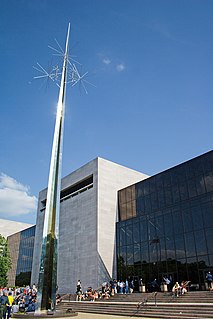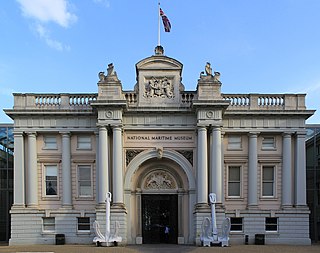
A museum is an institution that cares for (conserves) a collection of artifacts and other objects of artistic, cultural, historical, or scientific importance. Many public museums make these items available for public viewing through exhibits that may be permanent or temporary. The largest museums are located in major cities throughout the world, while thousands of local museums exist in smaller cities, towns, and rural areas. Museums have varying aims, ranging from serving researchers and specialists to serving the general public. The goal of serving researchers is increasingly shifting to serving the general public.

Entomology is the scientific study of insects, a branch of zoology. In the past the term "insect" was vaguer, and historically the definition of entomology included the study of terrestrial animals in other arthropod groups or other phyla, such as arachnids, myriapods, earthworms, land snails, and slugs. This wider meaning may still be encountered in informal use.

The Smithsonian Institution, also known simply as the Smithsonian, is a group of museums and research centers administered by the Government of the United States. It was founded on August 10, 1846, "for the increase and diffusion of knowledge". The institution is named after its founding donor, British scientist James Smithson. It was originally organized as the "United States National Museum", but that name ceased to exist as an administrative entity in 1967.

A science museum is a museum devoted primarily to science. Older science museums tended to concentrate on static displays of objects related to natural history, paleontology, geology, industry and industrial machinery, etc. Modern trends in museology have broadened the range of subject matter and introduced many interactive exhibits. Many if not most modern science museums – which increasingly refer to themselves as science centres or "discovery centres" – also emphasize technology, and are therefore also technology museums.

The National Air and Space Museum of the Smithsonian Institution, also called the Air and Space Museum, is a museum in Washington, D.C. It was established in 1946 as the National Air Museum and opened its main building on the National Mall near L'Enfant Plaza in 1976. In 2018, the museum saw approximately 6.2 million visitors, making it the fifth most visited museum in the world, and the second most visited museum in the United States. The museum contains the Apollo 11 command module, the Friendship 7 capsule which was flown by John Glenn, Charles Lindbergh's Spirit of St. Louis, the Bell X-1 which broke the sound barrier, the model of the starship Enterprise used in the science fiction television show Star Trek: The Original Series, and the Wright brothers' airplane near the entrance.

The National Maritime Museum (NMM) is a maritime museum in Greenwich, London. The historic buildings form part of the Maritime Greenwich World Heritage Site, and it also incorporates the Royal Observatory and 17th-century Queen's House. In 2012, Her Majesty the Queen formally approved Royal Museums Greenwich as the new overall title for the National Maritime Museum, Queen’s House, the Royal Observatory, Greenwich, and the Cutty Sark. The museum is a non-departmental public body sponsored by the Department for Culture, Media and Sport. Like other publicly funded national museums in the United Kingdom, the National Maritime Museum does not levy an admission charge, although most temporary exhibitions do incur admission charges.

The French National Museum of Natural History, known in French as the Muséum national d'histoire naturelle, is the natural history museum of France and a grand établissement of Sorbonne Universities. The main museum is located in Paris, on the left bank of the Seine. It was established in 1635 by King Louis XIII as the royal garden of medicinal plants, and in 1793, after the Revolution, it was reorganized in its present form and under its present title. As of 2017, the museum has 14 sites throughout France, including the original location at the Jardin des Plantes, which remains one of the seven departments of MNHN.

The National Museum of the United States Air Force is the official museum of the United States Air Force located at Wright-Patterson Air Force Base, 6 miles (9.7 km) northeast of Dayton, Ohio. The NMUSAF is the oldest and largest military aviation museum in the world, with more than 360 aircraft and missiles on display. The museum draws about a million visitors each year, making it one of the most frequently visited tourist attractions in Ohio.

The National Museum of American History: Kenneth E. Behring Center collects, preserves, and displays the heritage of the United States in the areas of social, political, cultural, scientific, and military history. Among the items on display is the original Star-Spangled Banner. The museum is part of the Smithsonian Institution and located on the National Mall at 14th Street and Constitution Avenue NW in Washington, D.C.

The National Museum of Natural History is a natural history museum administered by the Smithsonian Institution, located on the National Mall in Washington, D.C., United States. It has free admission and is open 364 days a year. In 2016, with 7.1 million visitors, it was the eleventh most visited museum in the world and the most visited natural history museum in the world. Opened in 1910, the museum on the National Mall was one of the first Smithsonian buildings constructed exclusively to hold the national collections and research facilities. The main building has an overall area of 1,500,000 square feet (140,000 m2) with 325,000 square feet (30,200 m2) of exhibition and public space and houses over 1,000 employees.

The Natural History Museum of Los Angeles County is the largest natural and historical museum in the western United States. Its collections include nearly 35 million specimens and artifacts and cover 4.5 billion years of history. This large collection is comprised not only of specimens for exhibition, but also of vast research collections housed on and offsite.

The National Museum (NM) is a Czech museum institution intended to systematically establish, prepare, and publicly exhibit natural scientific and historical collections. It was founded in 1818 by Kašpar Maria Šternberg. Historian František Palacký was also strongly involved in the foundation of the museum.

The National Museum of African American History and Culture (NMAAHC) is a Smithsonian Institution museum located on the National Mall in Washington, D.C., in the United States. It was established in December 2003 and opened in September 2016 in a ceremony led by President Barack Obama.

The National Museum of the United States Navy, or U.S. Navy Museum for short, is the flagship museum of the United States Navy and is located in the former Breech Mechanism Shop of the old Naval Gun Factory on the grounds of the Washington Navy Yard in Washington, D.C., United States.

The National Museum of the Marine Corps is the historical museum of the United States Marine Corps. Located in Triangle, Virginia near MCB Quantico, the museum opened on November 10, 2006, and is now one of the top tourist attractions in the state, drawing over 500,000 people annually.
A historic house museum is a house that has been transformed into a museum. Historic furnishings may be displayed in a way that reflects their original placement and usage in a home. Historic house museums are held to a variety of standards, including those of the International Council of Museums.

The National Museum of Scotland in Edinburgh, Scotland, was formed in 2006 with the merger of the new Museum of Scotland, with collections relating to Scottish antiquities, culture and history, and the adjacent Royal Scottish Museum, with collections covering science and technology, natural history, and world cultures. The two connected buildings stand beside each other on Chambers Street, by the intersection with the George IV Bridge, in central Edinburgh. The museum is part of National Museums Scotland. Admission is free.

A natural history museum or museum of natural history is a scientific institution with natural history collections that include current and historical records of animals, plants, fungi, ecosystems, geology, paleontology, climatology, and more.
















